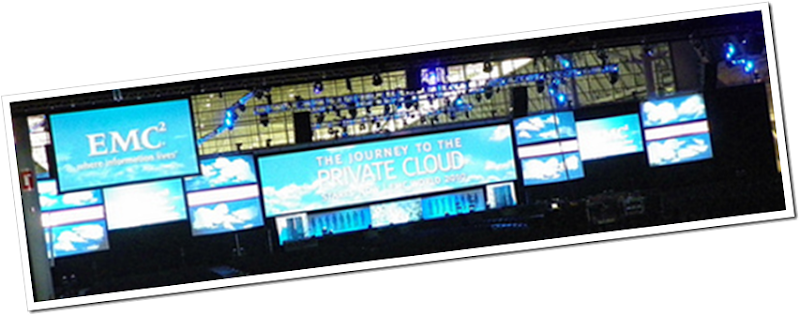EMC World 2010 – C’est fini!
Written by Joel Ramirez: (Big thanks to Joel for providing us with great coverage of the EMC World event! – Be sure to follow him on Twitter and LinkedIn.)
EMC World 2010 has wrapped up and it was overwhelming. I loved every minute though because I got everything I was looking for to help me do my job better. Between the hands-on workshops and advanced sessions, my peers from around the world doing their best to stump the chump, and the EMC Engineering folks who are the only bigger geeks out there than our collective, it really was a pretty amazing experience.
At the end of the day, there were plenty of techs there who, like me, just want to be confident in what they do. It certainly benefits the employer and the client when consultants are not only competent and experienced, but enthusiastic about technology. Like so many of my colleagues here at EMC World, I was a kid in a candy store this week.
My focus for EMC World 2010 included:
• Data Domain use cases (VMware and Symantec OST)
• Email archiving
• Fully Automated Storage Tiering (FAST)
• FLARE 30 feature set
• Celerra Celerra Celerra
The bulk of my clientele tend to be small-to-medium sized businesses or in the commercial sector. So much energy is spent on the big boys, so I made my trip up to Boston about the little guys that could really use my help relating the technology to their business needs. So the question is, what did I learn about that can help your business?
Email management
Email is a global, horizontal issue for companies. This means that everyone is having this problem, from law firms with a handful of partners to major corporations. I saw a lot of activity this week around continuing to address the issues with managing email.
Email is the one mission-critical application that everyone in your company touches and it can be a bear to manage. Even if you try to wrangle everyone in with their mailbox usage, employees spin off .pst archives or you have to make exclusions for the senior leadership. That’s why you have to stop fighting city hall and use technology to help you out. I always say that you should use technology to enforce policy. I have seen so many organizations modify business rules or lower expectations because the technology didn’t exist (or they didn’t know it existed) to enable the company to do what it really needed to do which, in this case, is control email sprawl and growth and increasing retentions.
Email archiving has come a long way and it is looking really versatile now. EMC SourceOne Email Management impressed me this week with the ability to ingest and limit future .pst generation. There are comprehensive services and new intuitive tools around migrating archive sources for even the largest environments now. You can migrate old EMC EmailXtender archives into a new SourceOne email archive, you can use SourceOne Email Management as the seamless overlay for all of the EmailXtender/SourceOne archives, and you can even migrate Lotus Notes and competitive product archives into SourceOne with the help of a company named TransVault Software.
The situation will dictate, but centralizing your email archive simplifies management, reduces storage cost, and mitigates risk. You don’t want gigs of .pst’s clogging up file shares and you certainly don’t want people walking out of the door with company information that you have no accountability for.
There are a lot of considerations to make beyond an archiving solution. Where do you put that archive, can I point it at a deduplicating array? Do I just shortcut the email or delete it from Exchange to make it only searchable from the archive? Do I really understand how big of a liability it is to manage my email via the status quo? Will my users benefit and will they have to experience performance issues and outages? Hit me up to talk more about this, it’s a big can of worms.
EMC VPLEX
I don’t have too much thought on this right now because, as I said, I was focused on solutions that affect my clientele now. However, I think that this technology is the first realistic and relevant hardware offering from EMC regarding their private cloud message. This technology will make a significant impact to any companies’ needs for highly-available, flexible storage technology that can leverage previous investments.
The VPLEX comes in an a couple of different configurations, Local and Metro. The Metro configuration extends a storage infrastructure by up to 100KM. The goal, EMC says, is to continue to extend this distance in future releases. The VPLEX is an engine, or a multiple thereof for redundancy and performance considerations, that is composed of two controllers. These controllers are BEEFY. Lots of processing power, lots of memory, lots of front end and back end ports. EMC loves to cross-pollinate technologies to make one product even better, and the VMAX engine architecture is all over these engines. They are modular, scalable, and pack some heat. Keep in mind I’m only emphasizing the intelligent strategy behind leveraging proven hardware architecture; the VPLEX is not VMAX in function.
So you take these engines and you spread them far and wide and attach some storage to them. The VPLEX GUI allows you to manage the storage and create a federated storage environment that has the ability to be geographically dispersed. The essence of the thing is that you can break out of any one array. Out of the gate it supports connectivity to several different vendors’ arrays.
Two things about the VPLEX seem to be what makes it tick: cache coherency and dirty region logs. The engineers kept it simple and used logic to eat this elephant. Cache coherency means that any of the engine’s cache communicates with all of the other engines’ caches to determine if a particular block of data is already out there. Remember that we are talking a lot of cache, and that’s the idea. Leave the spinning disk alone as much as possible! Dirty region logs speak to the high availability of the VPLEX. If a site or subset of the VPLEX engines go down, the hosts can still be serviced by the remaining engines. The logical volumes that the VPLEX is presenting to the hosts may have storage arrays or disks that are no longer available due to the outage, but VPLEX can continue to serve up data and, via the dirty region logs or DRL’s, keep track of the activity to resync the downed disk when they become available again.
There is so much more to say about EMC VPLEX, but I’ll save it for another blog post. All in all, a very cool technology that I can’t wait to see become a little more accessible to the SMB and commercial sectors.
Wrapping it up
I talked about some backup and consolidated storage topics and developments in previous posts, so please check those out to read about some of the things that got me excited about EMC World 2010.
Other things that got me excited were the short ribs on Monday, the hot and cold breakfast every morning, the clam chowder and booze tables at the Solutions Pavilion, and the abundance of attractive, really smart ladies of IT 😉
Talk soon,

